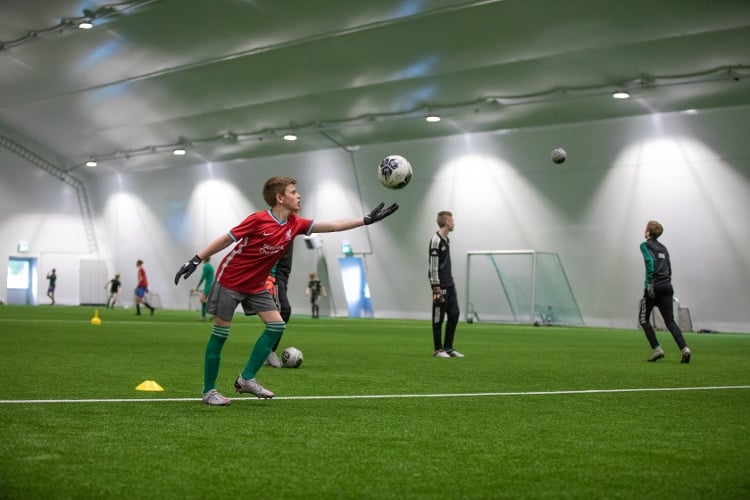18.01.2022
Listen to the blog
A fabric structure can be insulated to quickly create an affordable warm space. Of the more than 5,000 buildings supplied by Best-Hall so far, most are unheated warehouses, but the company has always been building insulated fabric structures as well, the proportion of which has been increasing in recent years. A fabric-covered building is usually insulated with wool batts or a metal-wool-metal element and blown wool. The first question when starting to design an insulated structure is whether the building needs to be warm or whether semi-warm is sufficient. These options have their differences, the most obvious of which are indoor temperature, cost and insulation thickness. The Finnish Ministry of the Environment has defined these in the National Building Code.
A semi-warm space is enough to play football
For warehouses and sports facilities, a semi-warm space is often sufficient. The Finnish Ministry of the Environment defines a semi-warm space as having an indoor temperature of at least +5 °C but less than +17 °C. The space is not intended for continuous occupancy in normal indoor clothing. A semi-warm space is more affordable because its insulation thickness is allowed to be less than that of a warm space. The unit used is the thermal transmittance coefficient, the U-value, which expresses how many watts of thermal energy can pass through the structure, i.e. how much heat can pass through a wall, for example.

The U-value requirement varies depending on whether the structure is a roof, a wall or a window, for example. The exact U-value of the entire building envelope is calculated based on the different U-values for walls, roof, etc. and their surface areas. More detailed instructions are available on the website of the Ministry of the Environment. To simplify, however, this can be defined as follows: The U-value or thermal transmittance of a wall must not exceed 0.26 W/m2K, which means a minimum insulation thickness of 150 mm. The insulation thickness depends to a large extent on the insulation material, e.g. 150 mm for wool batts. For roofs, the insulation must be thicker because of the higher heat loss through the roof. This U-value must not exceed 0.14 W/m2K. This requirement can be met with a 350-mm layer of blown wool, for example. In Best-Hall buildings, the blown wool is blown between the interior and exterior cladding.
Working may require a warm space
A warm space, on the other hand, is a building where people spend long periods of time wearing only indoor clothes. The temperature is +17 °C or higher. These include spaces such as production facilities in which a person could work though a whole day in indoor clothes. The insulation requirement is significantly higher and so are the construction costs. To achieve the U-value of 0.17 W/m2K required for walls, the insulation must be at least 230 mm. For the roof, the insulation thickness must be almost doubled to 600 mm to achieve a U-value of 0.08 W/m2K.
-1.jpg?width=1500&height=1000&name=Best-Hall_4191_LapWall%20(1)-1.jpg)
For further and more detailed information, see the Decree of the Finnish Ministry of the Environment on the Energy Performance of New Buildings (1010/2017).
On our website, you can take a look at some of the insulated projects we have carried out.
More are on the way, so also subscribe to the Best-Hall YouTube channel. See our website here: https://www.besthall.com/references
Yhdystie 3-7,
68300 Kälviä, Finland
Tel: +358 6 832 5000
info@besthall.com
Business ID FI01070190